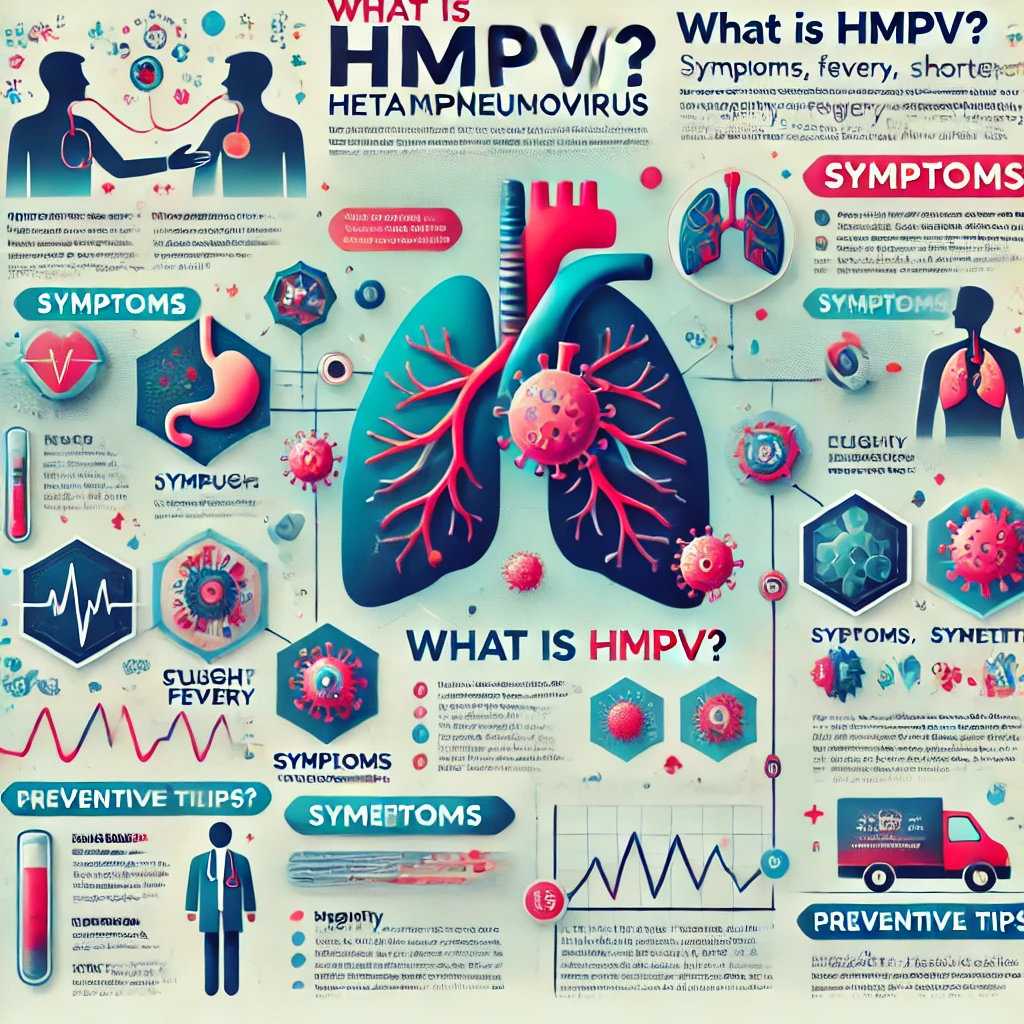Respiratory illnesses have always been a significant concern, especially in densely populated regions like India. While many people are familiar with common illnesses like the flu or COVID-19, fewer know about Human Metapneumovirus (HMPV). Discovered in 2001, HMPV is a respiratory virus that can affect people of all ages, causing symptoms ranging from mild to severe. Understanding HMPV is crucial for early diagnosis and prevention, particularly in vulnerable groups like children, the elderly, and immunocompromised individuals. This article dives deep into the causes, symptoms, prevention, and treatment of HMPV, equipping readers with the knowledge to protect themselves and their loved ones.
What is HMPV?
Human Metapneumovirus (HMPV) is a respiratory virus belonging to the Paramyxoviridae family, which also includes respiratory syncytial virus (RSV) and measles virus. HMPV primarily affects the upper and lower respiratory tracts and is a leading cause of respiratory infections globally. Since its discovery in 2001, researchers have identified it as a significant contributor to seasonal respiratory illnesses, particularly in children and older adults.
HMPV can cause symptoms ranging from a mild cold to severe respiratory distress, depending on the individual’s age, health status, and immune system. It often mimics other respiratory illnesses, making diagnosis challenging without specific tests.
How Does HMPV Spread?
HMPV spreads through respiratory droplets and direct contact with contaminated surfaces. Here’s how it typically transmits:
- Coughing or Sneezing: Infected individuals release droplets containing the virus into the air, which can infect others nearby.
- Touching Contaminated Surfaces: The virus can survive on surfaces for hours, making it easy to contract through touch.
- Direct Contact: Close contact, such as hugging or shaking hands with an infected person, can spread the virus.
HMPV infections are more common in late winter and early spring, aligning with the seasonal patterns of other respiratory viruses like influenza.
Who is at Risk of HMPV?
While HMPV can infect anyone, certain groups are more vulnerable:
- Infants and Young Children: Their developing immune systems make them more susceptible to severe symptoms.
- Older Adults: Age-related weakening of the immune system increases the risk of complications.
- Immunocompromised Individuals: Conditions like cancer, HIV, or organ transplants heighten susceptibility.
- People with Chronic Respiratory Conditions: Asthma or chronic obstructive pulmonary disease (COPD) can exacerbate symptoms.
According to global studies, HMPV is responsible for 5-15% of respiratory infections in children, highlighting its prevalence and impact.
Symptoms of HMPV
The symptoms of HMPV vary in severity but often resemble other respiratory illnesses. Common symptoms include:
- Runny nose
- Cough
- Fever
- Sore throat
- Shortness of breath
- Wheezing
In severe cases, particularly in high-risk groups, HMPV can lead to complications such as:
- Bronchiolitis
- Pneumonia
- Acute respiratory distress syndrome (ARDS)
Recognizing these symptoms early is crucial, especially in children and older adults, to prevent severe outcomes.
Diagnosis of HMPV
Diagnosing HMPV can be challenging because its symptoms overlap with other respiratory illnesses. Healthcare providers typically use:
- Clinical Evaluation: Doctors assess symptoms and medical history.
- Laboratory Tests:
- Reverse transcription polymerase chain reaction (RT-PCR) tests to detect viral RNA.
- Antigen detection tests for faster results.
- Viral cultures for detailed analysis.
Many cases go undiagnosed due to limited awareness and access to diagnostic tools, particularly in rural areas.
Treatment and Management of HMPV
Currently, there is no specific antiviral treatment for HMPV. Management focuses on relieving symptoms and preventing complications. Common approaches include:
- Symptomatic Treatment:
- Staying hydrated.
- Using over-the-counter fever reducers like paracetamol.
- Resting adequately.
- Oxygen Therapy: For severe cases with breathing difficulties.
- Preventing Secondary Infections: Antibiotics may be prescribed if bacterial infections develop alongside HMPV.
Timely medical attention is essential for individuals with severe symptoms, especially those in high-risk categories.
Preventing HMPV
Preventive measures are critical to reducing the spread of HMPV. Here are some effective strategies:
- Personal Hygiene:
- Wash hands frequently with soap and water for at least 20 seconds.
- Avoid touching your face, especially the nose, mouth, and eyes.
- Disinfection: Regularly clean and disinfect commonly touched surfaces.
- Avoid Crowded Places: During peak seasons, limit exposure to crowded spaces.
- Vaccination: Although no vaccine is currently available, research is underway to develop one.
Simple habits like covering your mouth while coughing or sneezing can significantly reduce transmission.
HMPV in the Indian Context
India’s dense population and diverse climates create an environment conducive to the spread of respiratory viruses, including HMPV. Challenges in the Indian healthcare system, such as limited diagnostic facilities and public awareness, exacerbate the issue.
Key Factors:
- Urban Crowding: High population density in cities facilitates virus transmission.
- Healthcare Access: Rural areas often lack access to advanced diagnostic tools.
- Climate Variability: Seasonal changes affect the virus’s spread and severity.
Public health campaigns emphasizing hygiene and early diagnosis can help mitigate the impact of HMPV in India.
Common Questions About HMPV
1. Is HMPV dangerous?
HMPV is generally mild but can become severe in high-risk groups. Early diagnosis and care are crucial.
2. Can HMPV recur?
Yes, reinfections are possible, as immunity to HMPV may not be long-lasting.
3. Is HMPV related to COVID-19?
While both are respiratory viruses, HMPV and COVID-19 are caused by different pathogens. Their symptoms may overlap, but they require distinct diagnostic and management approaches.
Conclusion
Human Metapneumovirus (HMPV) is a significant but often underrecognized respiratory virus. Understanding its symptoms, transmission, and prevention can help reduce its impact, especially on vulnerable populations. By practicing good hygiene, seeking timely medical care, and staying informed, individuals can protect themselves and their families.
Awareness is the first step toward prevention. Share this information with others and consult a healthcare provider if you or a loved one experiences symptoms of HMPV. Together, we can combat respiratory illnesses and promote a healthier society.



